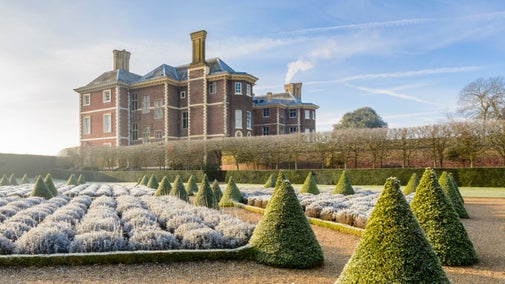
Discover more at Bateman's
Find out when Bateman's is open, how to get here, the things to see and do and more.

Bateman's is a Jacobean house, the date of 1634 is marked around the door. Set in the beautiful landscape of the Sussex Weald, Rudyard Kipling and his wife Caroline bought it in 1902 after falling in love with it. They lived here until their deaths in 1936 and 1939. Discover the rooms of the house just as the Kipling family left them.
Due to small rooms and to help look after collection items, we ask that if you bring a rucksack into the house, you wear it on your front.
The volunteer guides at Bateman’s have a wealth of knowledge about this place and the family which they love to share. Discover the fascinating story behind Rudyard Kipling’s family tree and his connections to Pre-Raphaelite artists, prime ministers and a fashionable reservoir in Staffordshire. Learn more about his wife and children, their life at Bateman’s, and the work of this Nobel prize winning author.
The front door leads into a hall with local oak panelling and a black and white floor, arranged around a large stone fireplace. Mrs Kipling had an office on the mezzanine, where she could keep an eye on unexpected guests arriving from the window.
In the hallway you can discover the intriguing story behind the brass fish and listen to the chimes of one of the oldest working clocks in the National Trust’s collection.
The walls of the Dining Room are decorated with embossed leather wallhangings, inspired by Indian chintz designs. They are covered with silver leaf and then varnished to make them glisten like gold.

– Rudyard Kipling in a letter to his cousin Ambrose Poynter
Mrs Kipling ran a tight ship: dinner was always at eight o’clock sharp, and everyone had to dress in their finery, even if there weren’t any guests. Dinner was usually a bland affair due to Rudyard’s stomach ulcers, and the family were restricted to dull meals such as steamed fish and blancmange. However, guests always commented that the wine was very good!

As you enter the Study it almost feels as though Kipling has just left and will return at any moment. The book-lined walls, his messy desk covered in ink spots and the day bed, with its cigarette burns, are evidence that this was very much his space. It is while looking out of this window onto the Dudwell valley, that Kipling was inspired to write his books Puck of Pook's Hill and Rewards and Fairies, which includes the famous poem If.
Kipling's Life and Legacy at Bateman's
The re-displayed exhibition delves into the fascinating life, work, and legacy of author Rudyard Kipling. Among the rare and unseen objects on display, you'll find a Japanese painted handscroll from the early Edo period, a wooden toy pig gifted by Kipling to his cousin Stanley Baldwin, and a well-travelled copy of his novel Kim, which accompanied the crew of the 1910 Terra Nova expedition to the South Pole.

The National Trust has acquired 'The Return of the Buffalo Herd', a rare watercolour painting from The Jungle Book, now on display in the house in the book’s anniversary year.
This painting, dated 1901, is one of just four illustrations known to have survived from the original set of 16 painted by the Detmold twins. The dark sentiment of the illustration lends a surprising contrast to lighter, modern interpretations of the story. It depicts a post-climactic scene, where protagonist Mowgli returns a herd of buffalo back to the village after using them to trigger a stampede that crushes his foe, the murderous tiger - Shere Khan.
In celebration of 'The Return of the Buffalo Herd' we are inviting visitors to explore the art of illustrating The Jungle Book. Carrie's Office has been transformed into a cosy reading space for children and adults to browse illustrated versions as well as hear a reading of the classic tale. Upstairs in the house is a new display showcasing illustrations of the book from around the world as well as the Walt Disney film illustration of these well-loved characters.

Find out when Bateman's is open, how to get here, the things to see and do and more.
Discover the garden at Bateman's. Find out what to see, from the Rose Garden designed by Kipling to wildflowers, an orchard and even a working mill.

Discover the history of Bateman's. Explore its 17th-century beginnings and why the house and garden were so special to Rudyard Kipling and his family.

Historic houses and buildings are full of stories, art and collections. Learn more about their past and plan your next visit.

From the art gallery at Petworth, to a cosy Arts and Crafts home at Standen, you'll be amazed at the variety of houses and unusual buildings to explore in Sussex.
